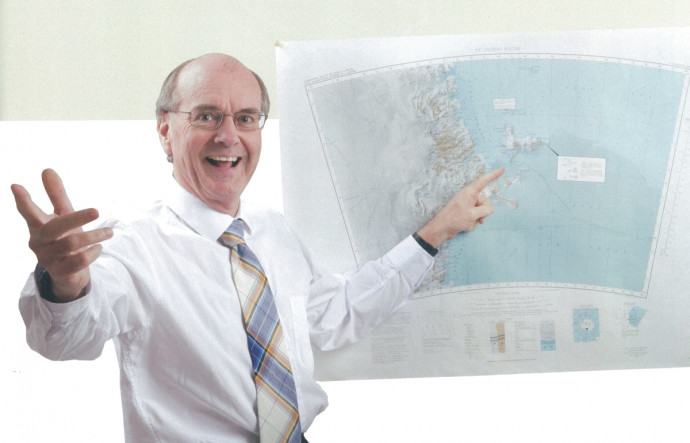2019 Thomson Medal: Outstanding science and technology leadership in a diverse array of domains

Dr Tim Haskell NZAM has been awarded the Thomson Medal by Royal Society Te Apārangi for his outstanding contributions to the organisation, support and application of science and technology in New Zealand in a wide number of domains.
These multi-dimensional endeavours range from developing DSIR’s first computer network, leading internationally renowned sea ice research infrastructure, implementing earthquake-safe building systems, NMR development, construction of manuka honey propolis extraction equipment, large-scale telescope componentry and translation of science to policy.
Dr Haskell began his career working in industrial heating and cooling in the time of New Zealand's first energy crisis, which led to his work on solar energy within the Department of Scientific and Industrial Research (DSIR), a former government science agency.
He then turned his attention to information technology systems, developing DSIR's computer network, which was one of the first in the world. This technology was spun off and later purchased by Allied Telesyn, based in Christchurch. While leading this work, Tim conceived and initiated a new project to develop high-speed processing using optical technology, which developed into the Photonics Group at Industrial Research Ltd (IRL) and later Callaghan Innovation.
At the same time, Tim became increasingly involved in Antarctic research, sea-ice research in particular, and became the New Zealand leader of the programme for decades, coordinating and mentoring sea ice research. “Camp Haskell” as it was known, was a focal point for nearly 40 years for researchers collecting data on seasonal sea ice formation and developing models to understand and predict global climate and climate change. Alumni from this group are now key researchers in critical climate research programmes, nationally and internationally. During this time, Tim was appointed Convenor of the Antarctic Environmental Assessment and Review Panel and provided advice to Government on the environmental implications of New Zealand's Antarctic activities, including the Southern Ocean fishery, Antarctic tourism and the New Zealand science programme.
One novel outcome of Dr Haskell's sea ice infrastructure management in Antarctica was Sir Paul Callaghan's ground-breaking NMR technology. Tim helped develop Sir Paul's formative ideas on a portable NMR measuring device, which they later used to study the brine content of sea ice.
In 1992, Tim was transferred to IRL, where he worked with Dr Bill Robinson to develop and test the base isolators of key buildings such as Te Papa and Parliament using the 'lead-rubber' earthquake building protection system.
Later Tim led a team developing the world's first high temperature superconducting system, which led to the development of an orthopaedic MRI using high temperature superconducting wire. The technology has since been commercialised.
He also worked on rebuilding the New Zealand Standard Time system, which is critical to industry by providing accurate timekeeping and authentication of digital transactions.
Another area of his work at Callaghan Innovation was to help construct and refine a medium-scale plant to extract components from manuka honeycomb.
One of the later phases of his career was the management of KiwiStar Optics – a Callaghan Innovation business unit that manufactures some of the largest telescope lenses ever made with contracts in the millions of dollars for large astronomical projects.
In making this award, the selection committee said that the central thread running through these varied scientific endeavours has been Dr Haskell's exceptional ability to bring together and guide teams in the most productive way, based on his deep understanding of how science works and how to overcome challenges.
Tim was awarded the New Zealand Antarctic Medal (NZAM) in the New Year Honours (2008), the Royal Society Te Apārangi Hector Medal (2007), the New Zealand Association of Scientists Marsden Medal (2006), and the Royal Society Te Apārangi Science and Technology Medal (1996). In 2009, Haskell Strait in Antarctica, which both Scott and Shackleton passed through, was named after him.
Tim gave his thanks to Royal Society Te Apārangi for recognising him with the Thomson Medal.
“In my 45 or so years in the science system in New Zealand, I have been fortunate to have worked with some interesting people, such as Bill Robinson on his base isolation devices, culminating in testing and certifying them for installation in Parliament and Te Papa. In addition, it was an interesting experience working with Paul Callaghan in Antarctica on the physical properties of sea ice where the results were discussed over a single malt. Both Bill and Paul went on to win Rutherford Medal.
“Being a member of the DSIR team that built one of the first world-class computer networks in New Zealand was an opportunity not to have been missed.
“Probably the highlight of my career was to have worked in Antarctica from the time when it was still like it was in Hillary’s day to the more modern era. We had a team of real blokesses and blokes down there and it is one of the things I still miss from time to time. To cap it off we had the fun of producing the “Men of Antarctica” calendar and I had the additional thrill of having Haskell Strait named after me.”
Thomson Medal:
For outstanding contributions to the organisation, support and application of science or technology in New Zealand.
Citation:
To Timothy George Haskell for leading, supervising, managing and supporting scientific endeavours including internationally renowned sea ice infrastructure, NMR development, large-scale telescope componentry and translation of science to policy
